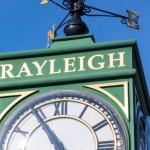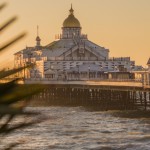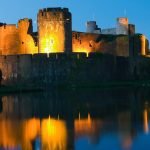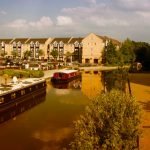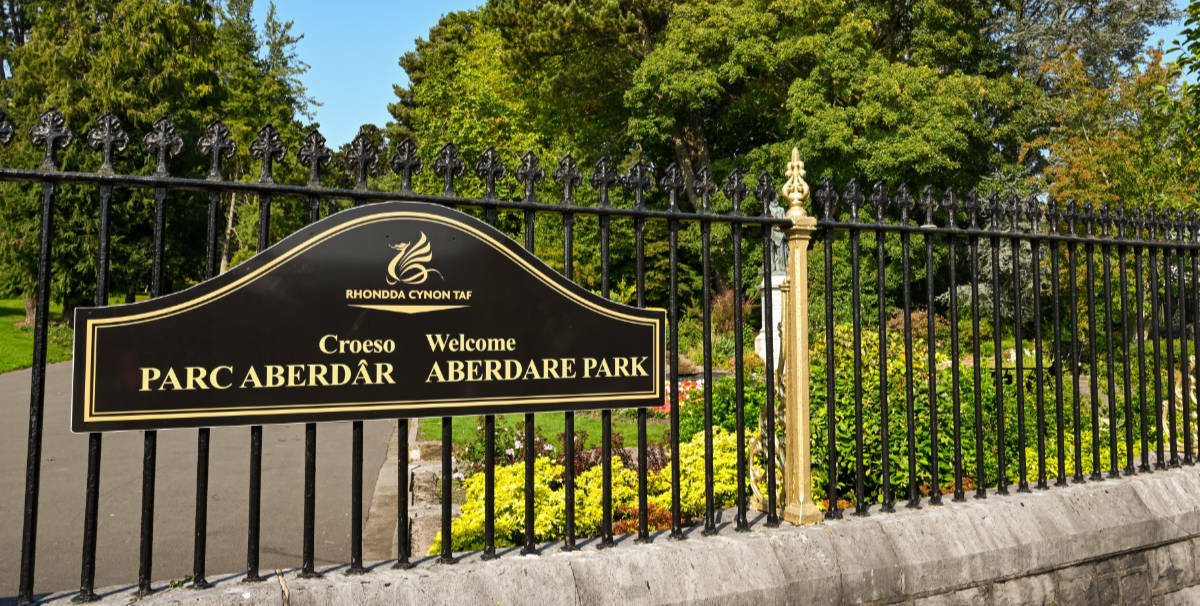
Aberdare dates back as far as the 1200s and beyond. Are you ready to take a staycation trip back through time?
Aberdare is a town situated in the Cynon Valley area of Wales. This is an area noted for its outstanding beauty and wildlife. Found where the two rivers of the Cynon and the Dare meet, Aberdare is about 20 miles from Cardiff as the crow flies.
With such quaint streets and so much history, this town makes a pleasant alternative to a summer vacation spent in the bustling city streets. If you want somewhere quiet, reflective, and good with kids, then a trip to Aberdare is no bad idea for a summer break. Here’s everything you need to know about this delightful Welsh town before you book your break.
The Early Days of Aberdare
The community here is said to have appeared around Saint John’s Church back in 1189. However… we put it to you that the church only built parishes where there was a need for them, and that therefore a town must have existed before the church opened. It’s a bit chicken and egg so we will move on. Fortunately for us, the Roman geographer Ptolemy left us a rough map of the tribes that inhabited Wales before we started Englifying it. According to him, there were 5 or 6 tribes in Wales when the Romans arrived just after 40 AD. He recorded that they were proficient with swords. This was later proven by Boudicca.
The south of Wales had three separate tribes. These were the Demetae, who controlled the capital, the Silures and the Dobunni. Ptolemy notes that two large tribes controlled the sea around Wales too, so that the whole area was vicious.
The Tribes of (Southern) Wales
Let’s investigate what we know about these three tribes.
The Demetae tribe lend their name to Dyfed. You found them west of the Silures. The tribe had gold mines at Dolaucothi where one of their main towns was. They also had the main town of Moridunum, which is modern Camarthen. In 1832, records showed that this area was suitable for sheep and not much else. Their name probably means ‘From the God Dagda’, who was a war-like god also associated with too much mead.
The Dobunni occupied the south of the country and into Gloucestershire and Somerset. The tribe’s name has lost its origins, although experts theorise it means ‘two halves’. It is possible that this Iron Age Celtic tribe was once two older tribes who joined forces. The Dobunni ejected the Romans at one point, as showed by their coinage. Later, the Hwicce tribe replaced the Dobunni. Their main city was built near a hot water spring. Legend holds that the city crystallised over time.
The Silures were war-like and conquered all they could. They bordered the Ordovices and the Dobunni, who presumably took a bit of a beating now and again. Interestingly, the Silures came from Spain at an earlier date. Their dark skin and curly hair led the Romans to believe they had landed in Europe. They were the experts in the Iron Age hill fort and littered the land with protective enclosures. They even built early, early roundhouses at Gwelhelog. If you want to know which clan in Wales gave the Romans the biggest losses, it was the Silures.
The Vikings Arrive
The Welsh were attacked by the Vikings and the English. The shores here hold some terrifying encounters. The first Viking raid recorded in Wales happened in 852. Vikings occupied the land at Anglesey and at Gwynedd from 854 onwards. They arrived in Wales because the Irish had kicked them out. You can learn more about the Vikings in Wales courtesy of the Welsh Museum. Needless to say that the Vikings left or intermingled and the Romans did the same. Say what you like about us Celts, we are a stubborn bunch.
All of this happened before we even get to the little church on the hill that supposedly started Aberdare. It is a shame that we so often go by church records simply because they are the only real written records that we have. The tax men did not include Wales in William the Conqueror’s Domesday Survey although the Normans did push west shortly after conquering England.
By the mid-11th century, Wales was united under the Prince of Gwynedd, one Gruffudd ap Llywelyn. He assaulted Saxon England and proved that the English border patrols were nothing more than a token effort. If his own people hadn’t turned on him, Wales might still be an independent country today. His own men lopped off his head and sent it to Edward the Confessor. King William split the country into counties as punishment. Revolts broke out repeatedly in Wales over leadership, with Henry I am commanding respect until his death. Henry II fought back against the Welsh armies in 1150. As of 1165, he had never successfully taken Wales. It was 1543 before Wales finally gave in and joined the union.
The Medieval Period in Cynon Valley
The first three hundred years of the medieval period in Aberdare were spent in fighting. The English invaded the Welsh and the Welsh invaded the English. Nobody won and everyone lost. The British Empire was unstoppable back then, so it was only a matter of time until the country became British. Even though the town went through slow growth during this period, the population never hit 1500 people. It was not until the Industrial Revolution that Aberdare really took off.
Fun Trivia About the Town
At this point, we usually find the information is getting a bit heavy. To remediate this, we stop and have a bit of a break and a chinwag. The chinwag always covers the hot gossip from the town we are touring. Let’s see what Aberdare has to offer:
- Aberdare earned the nickname of Brenhines y Bryniau, which means ‘Queen of the Hills’ when it grew back in the 1100s.
- Aberdare National Park spans 300 square miles. Scottish Geologist Joseph Thomson discovered it in 1884 and named it after the Celtic hills of Wales. Its about 93 miles west of Nairobi and features the Aberdare Mountain Ranges at it’s centre. Of course, the locals call them the Nyandarua Ranges, which is their real name. But let him have it. It was changed times.
- The population of Aberdare was only 1,486 people at the beginning of the 19th The modern town has almost 40,000 people. The population increased tenfold in a short period of time, leading to poverty that took years to fix.
- From 1870 onwards, coal mining dominated the area. This was how the locals made their wage and how the owner of the mines later paid for the town’s first hospital.
- Aberdare used to house a postgraduate agricultural college but it moved.
- 4 miles to the northwest of town was where the Prince of Dyfed was defeated by the English, driven by a Norman leader.
As you can see, there’s more to this seemingly sleepy town than might initially meet the eye. Let’s get back to history because the town grew exponentially during the Industrial Era.
The Industrial Period in Aberdare
Up until 1757, farming was the only real source of income in town. Iron working arrived and changed everything for everyone. A canal built in 1812 developed as a way to transport iron and coal to the rest of the country. The canal head was situated inside Aberdare itself. In 1720 a local manor house opened courtesy of one Mr Bruce. The estate home was a large employer in town and finally closed in the early 1900s. It was turned into a school and demolished in the 80s.
By 1851, only 10% of the population of Aberdare were immigrants. The rest all spoke Welsh. The language began to decline in the 1870s but never truly went away. By 1901, the census noted a drop in Welsh speakers so that only 71% of the population now spoke Welsh.
Eisteddfod
The town held its first National Eisteddfod in 1861, which resulted in many more being held over the years in the surrounding area. The town had its own newspaper from 1882 until 1865. It was replaced in 1875 with a more successful local rag. In 1862 St Margaret’s Church opened at a cost of an estimated £3000. The local Gadlys Iron Works opened in 1827 with more collieries following. The railway arrived in 1846. By then, the area of the Cynon Valley was known for its ‘black gold’. There are a number of old quarries in the area that stand testimony to the extensive mining and quarrying of the mineral wealth here. Miner’s rows of stone houses are common throughout the valley.
The nearby village of Mountain Ash was cut in two when the canal passed through it. They received a police station in 1865 as the two settlements merged. The main road opened in 1811 and the Board Of Health opened to clean up the town in 1854. The Workman’s Hall opened in 1904 at a cost of £5,000. The Aberdare Water Works opened in 1864 courtesy of Lord Aberdare. Several public houses and even the Mariner Hotel opened. A College opened and both a cottage and a fever hospital followed.
The Modern Day Welsh Town
In 1873 the town gained a gasworks and street lighting followed. Electric versions replaced horse-drawn trams in 1911. The mines began to close slowly, leaving the area without income. Ironmongers became thinner on the ground after Sir Thomas Powell, owner of the Powell Duffryn Company, died in 1863. By 1942 the coal and iron industries were in serious decline.
The town gained its hospital in 1917 when Joseph Shaw, local resident and chairmen of the Powell Duffryn Steam Coal Company, funded the first wards. When opened it had only 40 beds. Enough to supply sanctuary should there be any mining mishaps.
The town gained its primary school in the 1950s with Idwal Rees as the head teacher. Miners paid subscriptions back in 1938 to open a local theatre. The Coliseum Theatre remains the arts venue of the town to this day. Aberdare sent many of its young men to both Wars only to receive a handful of them back. Bombers in the area were spotted and recorded by the Welsh home guard, although the region was presumably too sparse to merit bombing properly. You can read about the Aberdare contribution to the war on Wales Online.
Mining Declines
Since the decline of the coal and mining industries, the town has found some economic footing as a retail base. It is the main shopping outlet for the whole valley. Keep in mind that there are more foxes and badgers here than there are people. Industries in town include manufacturing and engineering, both of which see interesting inventions over time, such as smokeless fuels and stronger cabling.
Modern-day Aberdare is a peaceful large town with a big population, set in some gorgeous countryside. Those that want a tranquil escape from the city – but who want to visit somewhere that has all they need – will do well having a holiday in Aberdare. It’s stunning, steeped in history, and you might find some ancient tribal coins. What’s not to love? We say get out there and explore.
Famous People from Aberdare and Rhondda Cynon Taf
This area of the country is reasonably far from London where most of the TV studios are. Nevertheless, there are a few famous people you might have heard of that emerged out of Aberdare. Here are our favourite famous faces you might spot at Tesco:
- The poet Alun Lewis, famous for his WWII poetry, was born nearby.
- The founding members of The Stereophonics come from a nearby village.
- Griffith Rhys Jones was the head of the award-winning choir for a time.
- Mihangel Morgan, a Welsh Language Writer
- Ioan Gruffudd, an actor named after the long usurped prince, is from here
- Lyn Evans was born here – the chief scientist on the Large Particle Hadron Collider project
- Lots of rugby players, including David Jones, Ian Evans, Jim Mills, and David Young
- Lots of footballers, including Rees Thomas, Lee Lucas, and Les Cartwright.
OK, so it’s hardly swimming in blue blood, but that’s all part of the charm. People come to Aberdare to get away from it all, not to bring the rat race with them. Let’s forget about our famous people failures and get on with the best things to see and do here. The town has a few hidden attractions of its own.
Best Things to See and Do in Aberdare, Wales?
Here are the local’s favourite things to see and do in Aberdare. There are attractions for all, but it’s the countryside that brings in the tourists. Here are some of the sites you can see in Aberdare.
Historic Sites and Landmarks
The local trail through the Cynon Valley has become a landmark. Shaping the land over time, this pathway has seen feet since the 1100s. This is a modern-day hiking and biking trail but know as you tread it that hundreds of years of Welsh history passes right under your feet as you do so. This is an 11-mile route so be prepared.
Another fun local landmark is the Robertstown Tramway Bridge. While this might once have transported trams across the water, it’s no longer fit for safe purpose. It’s still very pretty though, so go along and have a gander. Browse along the river while you are there for lovely views and potential wildlife.
Galleries and Museums
The Cynon Valley Museum Trust runs the local museum and tracks its people and important events. This place has some interesting old pictures of life in the industrial era. It holds all you need to know about the mining heritage and culture of the town. You can track down ancestral roots here or learn about the land before it was conquered. If you’re trying to track down distant relatives, this is a good place to start.
Although not technically a museum or a gallery, the Coliseum Theatre is still showing regular plays. See what is on while you are in town and remember that this place was funded by miners setting aside a part of their pay for better entertainment. The theatre is an excellent example of Welsh ingenuity at its finest. Plus, you know, the show could be fantastic.
Outdoor Attractions
This area is home to the Dare Valley Country Park. Set in 200+ acres of natural woodland, meadow, and rolling hills, this park has plenty of exploring to offer. The park is home to the Gravity Family Bike Park, so get biking out there. You can stay in accommodation inside the park too, or just enjoy the long walks, the scenery, and the fresh air of the valley.
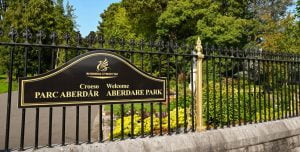
Image: Ceri Breeze/Shutterstock.com
If you think 200 acres is too much and you might get lost, check out the Aberdare Park in town instead. This is a good place to take the kids to let them burn off some energy. There is a swing/play set area, a space for ball games, and plenty of trees to climb. It’s good for sunbathing, too. Importantly, don’t confuse this with the Aberdare National Park in Africa because you will run out of petrol trying to get there.
Sports and Recreation
The town has a local football team called the Aberdare Athletic FC. They were in the Football League from 1921 to 1927 but Torquay United pushed them out. The club first opened back in 1892 and has a rich history.
There is genuine enthusiasm in all Welsh towns for throwing people around and we can see this in Aberdare RUFC. Also known as the Snakes, you can go along and take a stadium tour or watch a match.
Those who enjoy Britain’s other favourite ball game can find the local golf club just outside of town. Aberdare Golf Club has a gorgeous backdrop and stunning views to enjoy while you play. It’s south Wales too, so the weather is better than any Scottish course. The club opened in 1921 and hasn’t shut a day since.
You can visit the local Sobell Leisure Centre if you’d like to join a fitness class, use the gym, or otherwise recreate. Legend says it holds a swimming pool.
Shopping and Retail
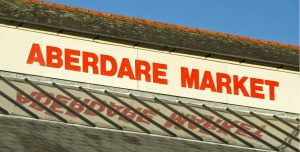
Image: Ceri Breeze/Shutterstock.,com
There are lots of industrial-style shops here to enjoy. There’s a What! Store that sell everything at a discount. There’s the Emporium for all things gifts. There’s a large Asda for all your groceries, and numerous other shops to enjoy. There’s even a B&M, which is the important one. Aberdare also has a fun indoor market at the local Arcade with great stalls and fresh local produce.
Other Notable Aberdare and Cynon Valley Attractions
If you are stopping in town for any longer than a few days, explore some of these sites, too:
- The town is surrounded by pleasant hiking trails like the Four Falls waterfall trail
- The Griffith Rhys Jones statue is still in the middle of the centre, go and marvel at it
- Take the kids to the Dragon’s Den, which is a soft play centre, we’re not monsters. Mostly.
- Visit the National Tap for a good drink.
How to Get to Aberdare
Now you know almost everything we do; except we haven’t given you dodgy directions yet. We say dodgy, we try our best. We would still fire up the sat nav though. Nothing says sure of your route like good-old Google maps.
By Road
Follow the A470 out of Cardiff
On The Train
Aberdare Train Station is on the Merthyr line.
Via Air
The nearest airport is Cardiff International.
By Sea
You are landlocked.
Got 5 Minutes to Spare?
If you are bored or just really, really, enjoyed our local guide to Aberdare, you can find more where this came from. Head to our website to find your own town’s guide, or to explore other staycation destinations. You can even show your support by following us on Facebook.
